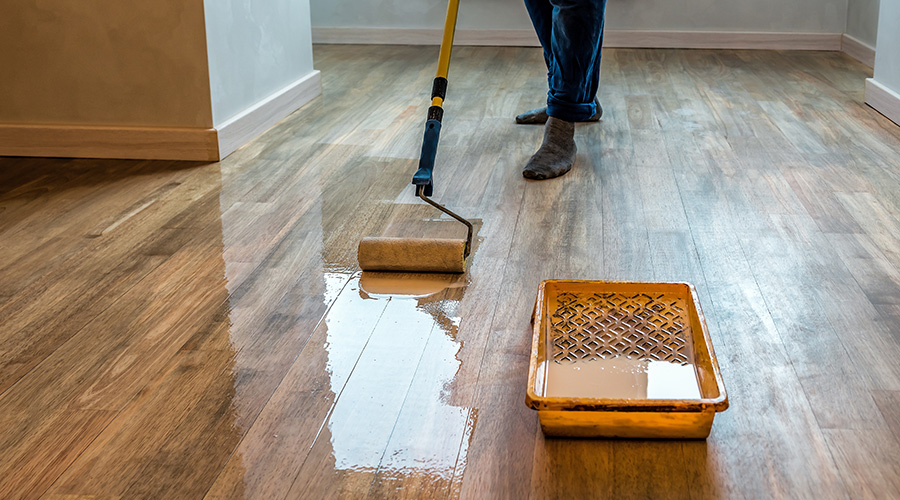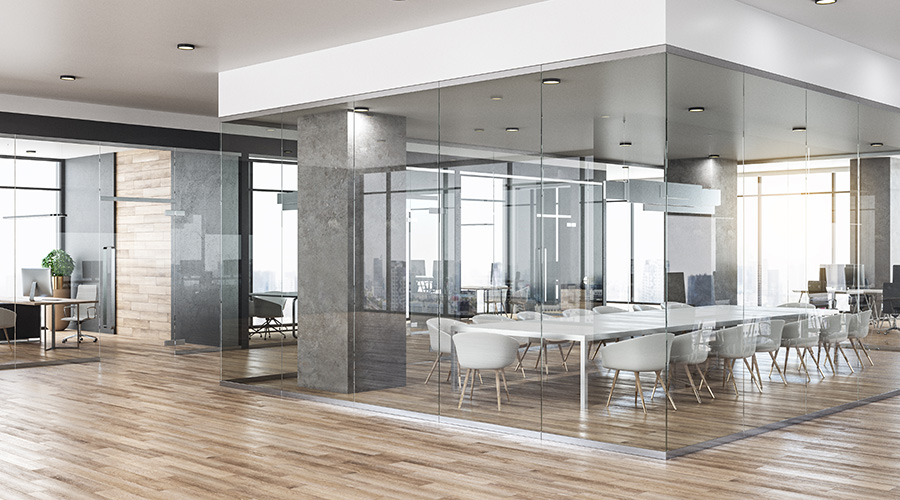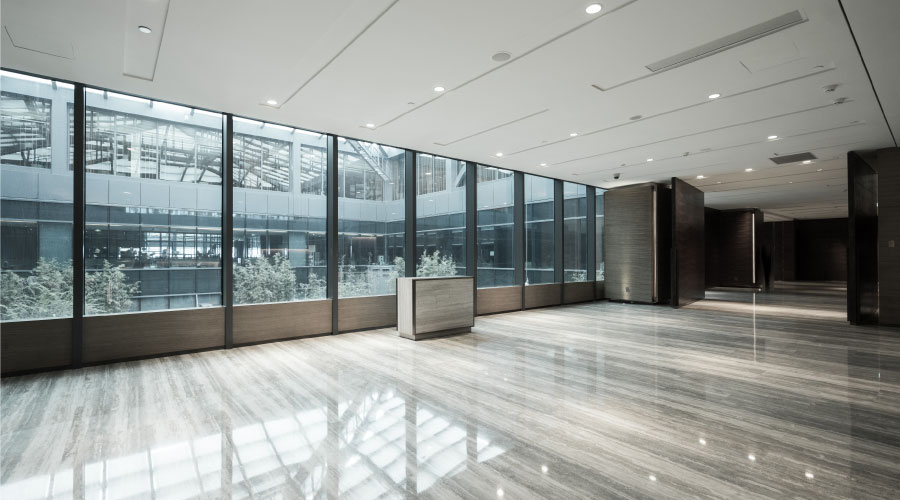It happens too often: An interior designer drives the carpet selection process with little input from those who maintain it. A year later, the carpet looks dirty, matted and beyond hope, and the finger pointing begins. The interior designer blames the facilities executive for poor maintenance, and the facilities executive blames the interior designer for poor carpet selection.
“If you know you’re going to get new carpet, get involved with the designer early on,” says Robert Peoples, director of sustainability for the Carpet and Rug Institute (CRI), the national trade association for the carpet and rug industry, and executive director of Carpet America Recovery Effort (CARE). “Carpet selection is not simple. It takes time.”
Often the first step in carpet selection comes when an interior designer presents an aesthetic concept to the end user, says Lee Martin, vice president of sales for J & J Industries. “It’s not that the designer neglects performance; it’s just not at the top of list. Their work centers around color and texture. Meanwhile, the facilities executive is responsible for keeping the carpet looking new, and their concerns are performance and durability.”
Industry experts agree that everyone will be happier with the end result if the decision making is a collaborative effort between facilities executives and designers.
The key to successful carpet selection is to think strategically and act tactically, says Mark Thomann, performance systems manager for the Mohawk Group. “It will save a lot of heartache and money. Remember, one size does not fit all.”
The first step in successful carpet selection is to understand traffic patterns. Hallways are perhaps the most heavily traveled areas. Living room floors and first-floor entrances typically endure the most abuse. The more battered the flooring is, the tougher the carpet must be.
“Traffic areas are obviously different around elevator banks than, say, board rooms,” says Cathy Mansour, director of marketing for Beaulieu Commercial.
Location Counts
Evaluating the specific needs of a space is the next step in selecting a product, says Jeff West, vice president of marketing for Shaw Contract Group. “Traffic, likelihood of spills, exposure to sunlight, desired life cycle and environmental attributes are key elements that should be considered for any space. A moisture barrier may be necessary in a health care or education facility but is not typically a requirement for corporate space.”
Even geography can affect carpet choice.
“Flooring is terribly abused anyway, and that abuse goes up dramatically where you’re dealing with snow and salt,” says Greg Wittlinger, executive vice president and general manger of Lees Carpet. “In the Southwest, you’re dealing with red clay.”
With these issues in mind, the success of a carpet is determined by face fiber, backing and maintenance, says Pieter van der Toorn, vice president of corporate accounts for Interface Flooring Systems.
Product evaluation should begin with a review of its appearance retention rating (ARR), a metric assigned by the Carpet and Rug Institute. The ARR evaluates changes in the appearance of the carpet surface based on simulated traffic wear. Results are graded on a scale of 1 to 5, where 5 represents no change in appearance and 1 represents severe change. A 3 rating indicates the carpet is suitable for heavy traffic areas.
True performance, however, is best determined in an actual setting, Thomann says. “People will spend a gazillion dollars on design, but rarely will they put the carpet in a space to see if it works. It’s smarter to figure out beforehand that a product does not work, than to try to figure out what to do with it afterward.”
Alternately, ask the manufacturer to provide case studies proving the product’s track record in similar facilities. The worst way to select carpet, experts agree, is to make decisions based solely on initial price.
“You can’t start with cost,” says Marc Ahrens, regional and market segment manager for Antron Carpet Fiber. “You can get good carpet for $20 a yard, and you can get lousy carpet for $20 a yard. You have to understand what you’re getting. With all the questions on the table, there are many different ways to go about getting to a budget.”
Decision makers start down the wrong path when carpet representatives present them with samples promised to be just as good as premium branded products.
Sometimes decision makers find themselves in a money crunch after they’ve borrowed from the carpet budget to fund other parts of a renovation or new construction project. “All of a sudden the general contractor is out of money,” Ahrens says. “Value engineering comes up. Then the facilities executive accepts an alternative because of budget.” The problem is that the lower priced product isn’t subjected to the performance scrutiny that should have gone into the initial selection.
In an ill-planned project, the initial cost can turn out to be only a fraction of the total cost, says Wittlinger of Lees. “You have to move all the furniture, disconnect the electrical, tear out the carpet, patch the floor, reinstall the carpet and bring everything back in. When do you find time to do that with employees in the building? What does disruption cost? It’s pretty substantial.”
Flooring specialists recommend that facilities executives determine in advance how long they expect the carpet to last. If the occupant has only a two-year lease, longevity might not be as critical as it is for an owner-occupant whose building plans extend decades.
“The longer you extend the life of the product, the more you’re going to control costs,” says van der Toorn of Interface. “If you pay more for fiber and upgrade backing, you can get an extra three or four years out of the product.”
“Floor covering is not a commodity,” says Wittlinger of Lees. “It may look the same, but fiber and backing are key to the carpet lasting longer. Make sure you select premium nylon. It’s more expensive upfront, but it lasts longer. Also consider the backing. With moisture, cleaning and spills, melting snow and rain, you have to make sure it won’t deteriorate. If you don’t use the right backing or fiber, you’ll have to replace it or spend more to maintain it.”
When there’s no way around the budget, facilities executives and designers can use their knowledge of wear patterns to develop strategic solutions. Instead of installing the same carpet throughout the building, less expensive carpets can be installed in low traffic areas. The cost difference can be applied toward better grade carpet for more heavily traveled spaces, says van der Toorn of Interface.
“You can still be color coordinated, but you can come up with specific solutions for specific areas rather than assuming one size fits all,” he says.
Keep It Clean
The best planning and most careful selection aren’t enough to ensure that carpet will maintain its appearance.
“Commitment to a cleaning and maintenance program will give you the expected level of performance,” says Peoples of CRI.
Ray Dunn, vice president of global business development for Tandus, agrees. “How you maintain the carpet affects appearance over time. The longer you can make it look good, the longer you can keep it down and reduce costs.”
Dirt causes carpet to degrade. Dunn recommends cleaning spots immediately.
Daily sweeping with a good vacuum cleaner equipped with a beater bar helps too, says Wittlinger of Lees. “The most effective ways to keep carpets clean are often overlooked. Just vacuum the carpet before dirt accumulates. That makes for a healthy indoor environment too.”
When you have to clean it, use only cleaning products with the CRI Seal of Approval. They have been tested to ensure they won’t promote re-soiling, won’t damage the fiber, and won’t affect the color fastness of it. “Soap on carpet makes it re-soil much more quickly if you don’t get all of the soap out,” he says.
Color plays a critical role in appearance. “There’s no carpet that will clean itself, and there’s no carpet that won’t look dirty eventually,” says Martin of J&J Industries. “The lighter the carpet, the quicker it looks dirty. A lot of color hides a lot of sins.”
Mansour agrees. “Selecting light colors for high traffic areas causes premature soiling, additional maintenance cost and embarrassment because the carpet looks bad.”
Variegated colors may maintain their appearance longer than solid colors, says Wittlinger of Lees. “A combination of light and dark colors is better at camouflaging dirt. You want a nice blend of colors, particularly if you don’t have a good maintenance program or can’t get to spills quickly.”
Walk-off mats located at entrances and in elevator lobbies help to keep dirt off the carpet in the first place. This is particularly important when the entrance is directly attached to a garage or parking lot. “Guard the doors,” says Thomann of Mohawk Group. “When you start getting a high level of silicon or grit on the carpet, that will cut nylon.”
“If the carpet is not maintained, it shortens the life cycle and increases the environmental footprint of carpet,” says Peoples of CRI. CRI’s Web site provides information on the fundamentals of carpet cleaning and care as well as updates on the latest advances in cleaning equipment.
Historically, few carpets were selected with the environment in mind. Nobody cared how they were manufactured, what they were made of, how they affected the building, or what happened to them once they were ripped out. That mindset is changing.
One reason is LEED — Leadership in Energy and Environmental Design — the green building rating system designed by the U.S. Green Building Council. LEED has fed a broad and growing interest in measures to reduce the impact of buildings on the environment.
Sometimes the challenges of green design and operating practices can leave facilities executives scratching their heads over where to start.
Start by figuring out how to dispose of the old flooring responsibly, says van der Toorn of Interface.
“Ask up front, ‘What is going to happen to old material? What are the alternatives for keeping the old carpet out of landfills?’”
If the questions aren’t met with a blank stare, the answer usually is “recycling.”
Unfortunately, recycling comes at a cost that probably wasn’t in the budget — particularly if the idea is an afterthought. At that point, the facilities executive must ask, “How much are we willing to pay to keep the old carpet out of a landfill?” If cost is a big issue for an organization, then the landfill probably won’t be.
Facilities executives should consider it a lesson learned, Peoples says. The next time, they should ask the manufacturer what happens to the carpet at the end of its life. Some products coming to market now are designed to be recycled, but industry evolution is slow and cumbersome.
Peoples recommends that facility executives review environmental reports published on carpet mill and fiber manufacturer Web sites. “Nothing is routine and simple about recycling. Some companies are further along than others, but in general, recycling post-consumer carpet is a nascent business in the United States today,” he says.
Dunn of Tandus agrees. “About 98 percent of all used carpet goes into a landfill. We’re working hard to bring it back and recycle it. We bring back 100,000 yards a month to recycle, but most still ends up in a landfill. As an industry as a whole, we’ve done a poor job of recycling. You hear glowing stories about the future, but we’ve got a long way to go. Today, the issue is recycling costs versus the landfill. To change that, everyone who touches the old carpet has to say, ‘Hey, we want it recycled. We don’t want it thrown into a landfill.’”
If recycled content or recyclability is important, facilities executives must make sure they understand exactly what the manufacturer means when it makes these kinds of claims.
Beyond Green Fibers
Wittlinger of Lees suggests that carpet buyers look for third-party certification to substantiate the manufacturer’s claims. “Third-party certification will help you feel more comfortable that the manufacturer is doing what they’re saying they do.”
The good news about carpet is that sustainability and economics go hand in hand. Careful shopping can lead to ecologically friendly decisions. Choosing carpet that is going to last longer is the most obvious way to reduce the environmental impact, says Ahrens of Antron.
Buying products made from less material is another positive move, says van der Toorn of Interface. “Can you buy a product that uses 18 ounces of material and gets the same performance as 24 ounces? If the answer is yes, less is more.”
Van der Toorn suggests that carpet buyers ask what the manufacturers are doing in terms of pursuing renewable energy and how clean their smoke stacks are. He also recommends inquiring about efforts to obtain ISO 14001 certification. ISO 14000 is a series of international standards on environmental management.
“The answers can be quite surprising and will help you determine whether the manufacturer is truly environmentally conscious or is just playing the green card,” he says.
About CRI
The Carpet and Rug Institute (CRI) is the national trade association representing the carpet and rug industry. Headquartered in Dalton, Ga., the association’s membership consists of manufacturers representing more than 90 percent of all carpet produced in the United States, and suppliers of raw materials and services to the industry.
Check the group’s Web site for information about the aesthetic, functional, and financial benefits of carpet, the selection process, installation guidelines, the characteristics of fibers, carpet construction, carpet’s role in indoor air quality and the environment, daily maintenance and long-term care, and in-depth technical guidance.
|











